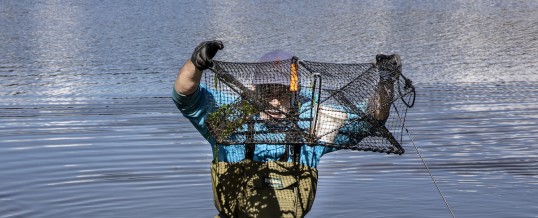
April 10, 2024
While 2023 already seems like an eon ago, last year’s trapping season is still very much on our minds even as we launch the 2024 monitoring effort. The winter is a time for green crab managers to regroup, review data to interpret green crab population patterns and think about strategies for the coming year. In December, WSG hosted our third annual Trapper’s Summit, a day-long workshop for trapping partners all over the state to come and share their observations from the previous year. And in February, Washington Department of Fish and Wildlife held a 2-day symposium with policy, research, and green crab status updates for everyone interested in learning about the efforts. These were critical opportunities for the collaborating partners to start to piece together the stories of green crabs in 2023.
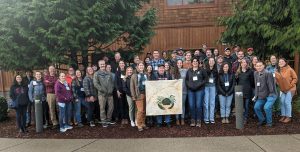
WSG brought together trapping partners in Shelton in December, to debrief from the season’s observations and data.
In this post, we’ll summarize some of the big patterns and themes of green crab status from around the state. This information was collected both by trapping partners as well as the Crab Team monitoring network – so there are many boots in the mud behind the data (see the footer for the full list)! And there is so much information, we’ll share it across two posts. This first post will focus on inland shorelines (from Cape Flattery east and north to Blaine), and we’ll follow up with a post on coastal geographies (from Cape Flattery south to the Columbia River).
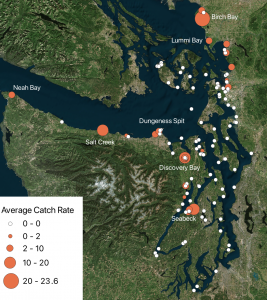
Figure 1. Map of 2023 green crab catch rates (average number of crabs per 100 trap sets) across inland geography. This represents efforts of all inland trapping partners, tribes, and agencies. Click to enlarge.
Inland
Overall, in 2023, Washington shorelines within the inland waters of the Salish Sea showed a continuation of the 2022 trends: sparse populations, several of which are heavily trapped, and a slight increase in overall range and numbers (Figure 1). Here we break it down by regions where green crabs were observed last year. All of the regions where green crabs have previously been found had some sites where numbers of crabs or catch rates increased significantly, as well as sites where numbers held steady or went down (Figure 2), both of which likely reflect the influence of both trapping effort as well as some help from nature (more on that later).
Two trends across inland geographies in 2023 also bear mentioning:
- Compared to 2022, relatively low recruitment was observed. Even toward the end of the trapping season few sites had captured many or any young of the year. By contrast, many sites in the northeastern geography (Whatcom and Skagit counties) trapped a bump of young of the year at the end of 2022.
- 2023 held the record for number of egg-bearing (gravid) female crabs being trapped. Even when they are present at a site, gravid females come to traps at a lower rate than males, or females without eggs. They do still occasionally turn up in traps, which is typically interpreted as a sign that the population is relatively large and established. In 2023, 11 gravid females were captured in total, across three sites: Drayton Harbor (5 crabs), Dungeness Spit (2) and Samish Bay (4). Gravid females had been captured at Samish Bay (3) and Drayton Harbor (2) in previous years, but only as hand captures in the winter by shellfish growers. Showing up in more frequency in traps, and at a new site (Dungeness) was a definite shift in 2023.
Where aren’t green crabs across inland shorelines?
As much as green crab continue to be found at a few new sites each year, there remain large regions of the Washington portion of the Salish Sea where they have never been detected, despite searching. The Crab Team map highlights green crabs captured in this geography, showing that as of 2023, green crabs had still not been detected in central or south Puget Sound (below the southern end of Whidbey Island), or in the Whidbey Basin (east of Whidbey Island). Green crabs also hadn’t been captured on the southern portions of Hood Canal, and hadn’t been seen in the San Juan Islands since 2019 (and even then only at a single site).
In addition, by looking closely at the capture sites, you might also notice that, even in water bodies where green crabs have been found, their captures are very concentrated, often around an area of salt marsh, or a small stream channel at the head of a bay or water body. This reflects the green crab’s preferred habitat types, particularly as juveniles. As individual crabs grow larger, they are better able to survive amidst larger more threatening predators and can sometimes be found out in slightly deeper (shallow subtidal) water near these “core” survival habitats.
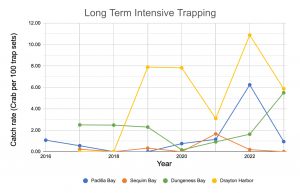
Figure 2. Graph showing average annual catch rate at four sites with intensive long term trapping efforts, Padilla, Sequim, and Dungeness Bays, and Drayton Harbor. (Click to enlarge)
On the North Olympic Peninsula:
- A smattering of new detection sites, including Neah Bay, Salt Creek, and Port Angeles, highlighted that this region has been exposed to green crab larvae in the past few years, particularly along the western reach. While most of the shoreline of the western Strait of Juan de Fuca is rock and cobble bench and not the most favorable for green crabs, these sites are pockets of lower energy habitat and can offer refuges for survival.
- Further to the east, managers working at Dungeness National Wildlife Refuge (USFWS) and Discovery Bay (WDFW and Jamestown S’Klallam) documented particularly high catches. At Dungeness Spit,
trappers captured 105 green crabs over the 2023 season, topping their previous record in 2017 – the first year green crabs were found at the site. Discovery Bay, after being uncovered as a hotspot at the end of 2022, remained a site with one of the highest catch rates in inland waters in 2023 (Figure 3). - Some good news comes from the region as well. In Sequim Bay where collaborative trappers uncovered no green crabs in 2023 in spite of captures in previous years. Only one crab was captured on Indian Island in 2023, during a large assessment effort by WDFW and the US Navy.
Hood Canal:
- At Seabeck in 2023, both monitors and managers continued to find green crabs in Nick’s Lagoon, at about the same rate as 2022. Notably, despite only yielding a single green crab in 2022, the nearby Big Beef Creek estuary outpaced Nick’s Lagoon in terms of catch rate in 2023 (14 vs. 7 green crabs per 100 trap sets).
- Two portions of Hood Canal yielded new detections this year, Dabob Bay and Thorndyke Bay. Thankfully, in spite of being new detections, in both locations, catch rates were relatively low for the season (Dabob: 1 crab per 100 traps, and Thorndyke 0.4 crabs per 100 trap sets). However, given the retentive circulation in this region, ongoing trapping could be important to limit local population growth.
Central and South Sound:
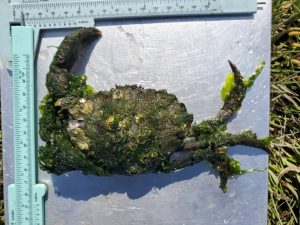
This large dead European green crab was found by Crab Team volunteers during their July molt survey at Hancock Lake on Whidbey Island. So far it is the only evidence of green crabs to be found at that site. (Photo courtesy of Kathy Ridle)
- In July of 2023, a dead green crab was detected by Crab Team volunteers monitoring Hancock Lake on Whidbey Island during their surveys. Though this is a new site for green crab detections, no live crabs were found there this year. No detections at the nearby Lagoon Point monitoring site, where green crabs have not been detected since 2018.
- In the main stem of Puget Sound (that is, excluding Hood Canal), green crab presence has not been confirmed south of Admiralty Inlet. Monitoring sites and exploration trapping by partners in south and central Puget Sound (DNR and WDFW) have thus far yielded no detections of green crab.
Northeastern:
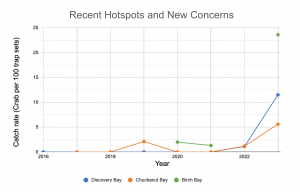
Figure 3. Three sites thats showed significant increase in capture rates of green crab in 2023, Discovery, Chuckanut and Birch Bays. Note that no trapping took place in Birch Bay in 2022, accounting for the lack of data that year. (Click to enlarge)
- At locations with large and long term trapping efforts (Samish and Padilla Bays, Drayton Harbor), the season started off by doing “clean up” on a large number of young-of-the-year green crabs that arrived late in the season in 2022. Drayton and Padilla Bay saw a drop in overall catch rates in 2023 relative to the previous year (Figure 1). But Samish Bay had a slight increase, driven largely by one site within the Bay.
- While there were no water bodies in this region with entirely new detections, a few with previously sparse detections had significant increases or expansions in 2023. In Birch Bay, Terrell Creek held the record for inland catch rates for a single site this year – topping out at an average of 24 crabs per 100 trap sets (Figure 2). Chuckanut Bay also increased somewhat in 2023, and in Bellingham Bay, green crabs were detected at a new site, Post Point Lagoon.
- Highly intensive trapping efforts continued in 2023 on the Lummi tidelands and in the sea pond. In spite of more trap sets than ever, Lummi captured more than 6,000 green crabs in 2023, less than one tenth of the catch from the two previous years, but still three times the catch as in 2020. This means that overall, Lummi observed a substantial decrease in the average catch rate of green crab compared to previous years. Along with only scant evidence of young of the year recruiting into the population, this is a promising early sign that trapping is having the intended effect. Managers at LNR have noted that it’s likely that two intense winters in a row were powerful allies that helped reduce recruitment and enable trapping to be most effective.
Stay tuned for our trip out to the coast in the next post… in the meantime, check out additional resources at the WDFW Green Crab hub
—Emily Grason
Kudos to the extensive list of partners who contributed to this work: Washington Department of Fish and Wildlife, Northwest Straits Commission, Lummi Natural Resources Department, Washington Department of Natural Resources, Makah Tribe, Padilla Bay National Estuarine Research Reserve, Lower Elwha K’lallam Tribe, Jamestown S’Klallam Tribe, Tulalip Tribes, Suquamish Tribe, US Navy and of course the hundreds of partner and volunteer monitors with the Crab Team monitoring network!
APR
2024